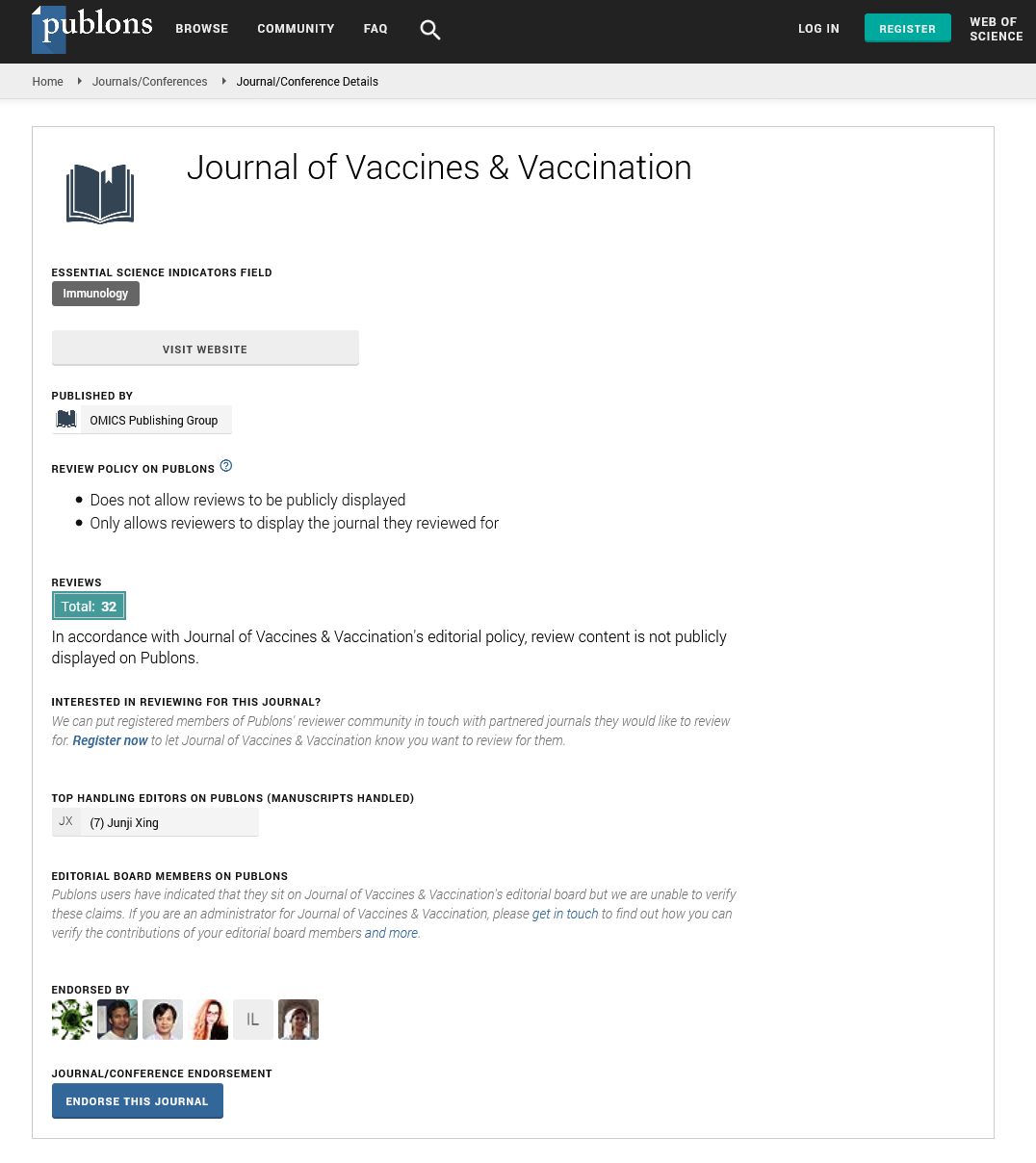Indexed In
- Academic Journals Database
- Open J Gate
- Genamics JournalSeek
- JournalTOCs
- China National Knowledge Infrastructure (CNKI)
- Scimago
- Ulrich's Periodicals Directory
- RefSeek
- Hamdard University
- EBSCO A-Z
- OCLC- WorldCat
- Publons
- MIAR
- University Grants Commission
- Geneva Foundation for Medical Education and Research
- Euro Pub
- Google Scholar
Useful Links
Share This Page
Open Access Journals
- Agri and Aquaculture
- Biochemistry
- Bioinformatics & Systems Biology
- Business & Management
- Chemistry
- Clinical Sciences
- Engineering
- Food & Nutrition
- General Science
- Genetics & Molecular Biology
- Immunology & Microbiology
- Medical Sciences
- Neuroscience & Psychology
- Nursing & Health Care
- Pharmaceutical Sciences
Commentary - (2024) Volume 15, Issue 6
Role of Bacillus Calmette-Guérin (BCG) Vaccine in Tuberculosis Prevention: Mechanisms of Action, Limitations, and Innovations in Vaccine Development
Hevin Magg*Received: 23-Sep-2024, Manuscript No. JVV-24-27020; Editor assigned: 25-Sep-2024, Pre QC No. JVV-24-27020 (PQ); Reviewed: 09-Oct-2024, QC No. JVV-24-27020; , Manuscript No. JVV-24-27020 (R); Published: 25-Oct-2024, DOI: 10.35248/2157-7560.24.15.575
Description
The Bacillus Calmette–Guérin (BCG) vaccine is one of the oldest and most widely used vaccines in the world. Developed in 1921, it remains the only licensed vaccine for Tuberculosis (TB) prevention. TB, caused by Mycobacterium tuberculosis (M. tuberculosis), remains a significant global health challenge, leading to millions of infections and deaths annually. While the BCG vaccine has been important in preventing severe forms of tuberculosis, particularly in children, its limitations, especially in adult populations, have fueled efforts to innovate and develop more effective vaccines.
The BCG vaccine is a live attenuated strain of Mycobacterium bovis, closely related to M. tuberculosis. Its primary mechanism of action involves stimulating the immune system to recognize and respond to mycobacterial antigens. Upon administration, BCG is taken up by antigen-presenting cells (APCs), such as macrophages and dendritic cells, in the skin. These APCs process the BCG antigens and present them to T cells, particularly CD4+ and CD8+ T cells, which play a critical role in controlling TB infection.
BCG induces both innate and adaptive immune responses. The innate immune response involves macrophages and natural killer cells, which help limit the initial infection. The adaptive immune response, particularly the activation of CD4+ T helper cells and CD8+ cytotoxic T cells, is essential for long-term protection. These cells produce cytokines like interferon-gamma (IFN-γ), which helps activate macrophages to kill the M. tuberculosis bacteria more effectively.
BCG also generates immunological memory, which allows the immune system to respond more rapidly and effectively upon subsequent exposure to M. tuberculosis. This memory is key to preventing severe forms of tuberculosis, such as miliary TB and TB meningitis, particularly in children.
Despite its long history and widespread use, the BCG vaccine has notable limitations. One of the main challenges is its variable efficacy in preventing pulmonary TB, the most common form of the disease. While BCG offers significant protection against severe forms of TB in children, it is much less effective in adults, especially in regions where TB is endemic.
Several factors contribute to this variability in efficacy. Geographic differences in TB incidence and exposure to Non- Tuberculous Mycobacteria (NTM) in the environment may affect the immune response to BCG. People living in areas with high exposure to NTM may develop cross-immunity, which can reduce the effectiveness of BCG against M. tuberculosis. Furthermore, the BCG vaccine does not offer robust protection against latent TB infection, which affects nearly one-quarter of the global population and can lead to reactivation of active disease.
Conclusion
The BCG vaccine has played an essential role in reducing the global burden of tuberculosis, particularly in children. However, its limited efficacy in adults and inability to prevent latent TB infection underscore the need for improved vaccines. Ongoing research into new vaccine candidates, including booster vaccines, recombinant BCG, and mRNA-based approaches, offers hope for more effective prevention of TB in the future. As the global fight against tuberculosis continues, innovation in vaccine development remains critical to achieving long-term control and eventual eradication of this disease.
Citation: Magg H (2024). Role of Bacillus Calmetteâ??Guérin (BCG) Vaccine in Tuberculosis Prevention: Mechanisms of Action, Limitations, and Innovations in Vaccine Development. J Vaccines Vaccin. 15:575.
Copyright: © 2024 Magg H. This is an open access article distributed under the terms of the Creative Commons Attribution License, which permits unrestricted use, distribution, and reproduction in any medium, provided the original author and source are credited.

